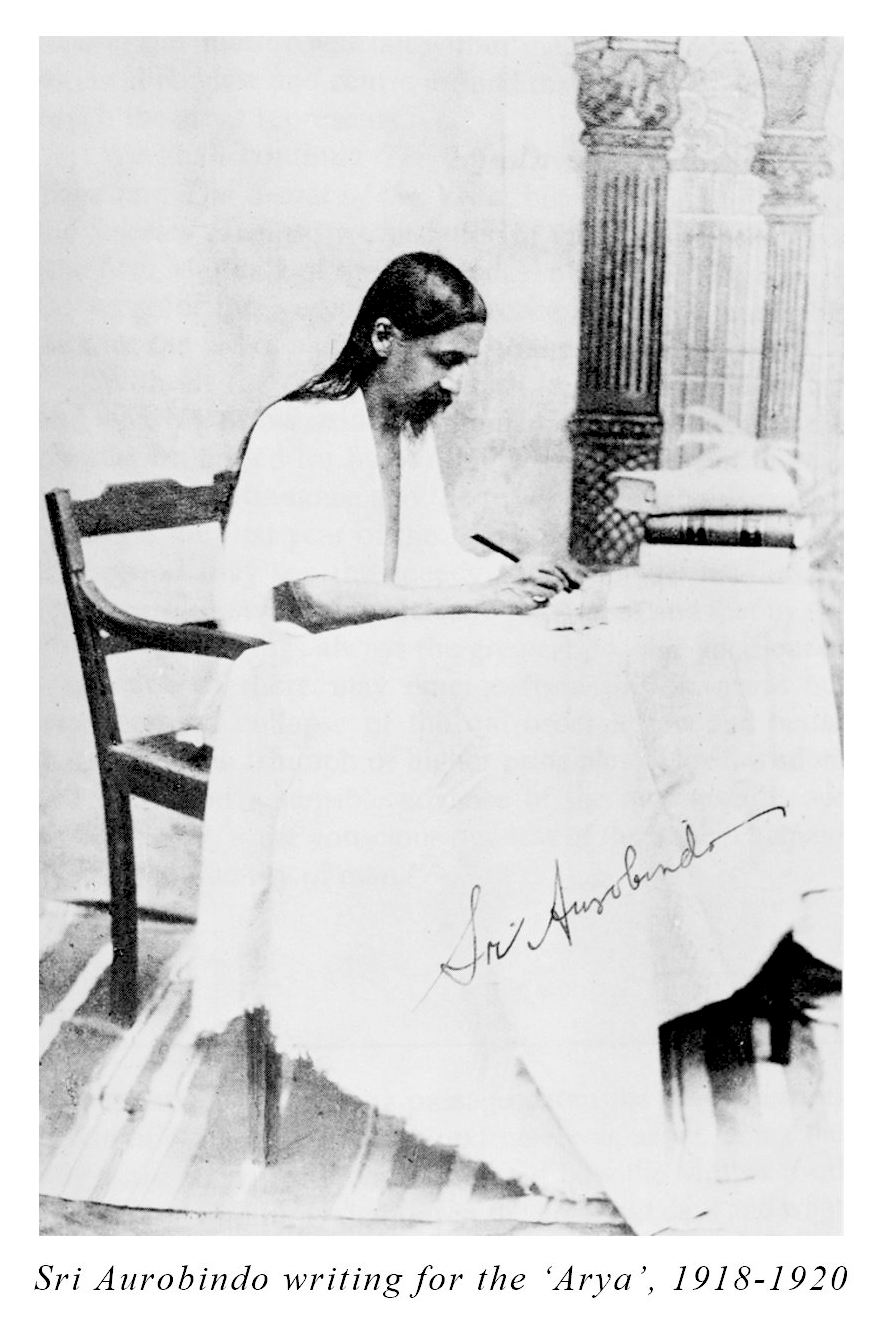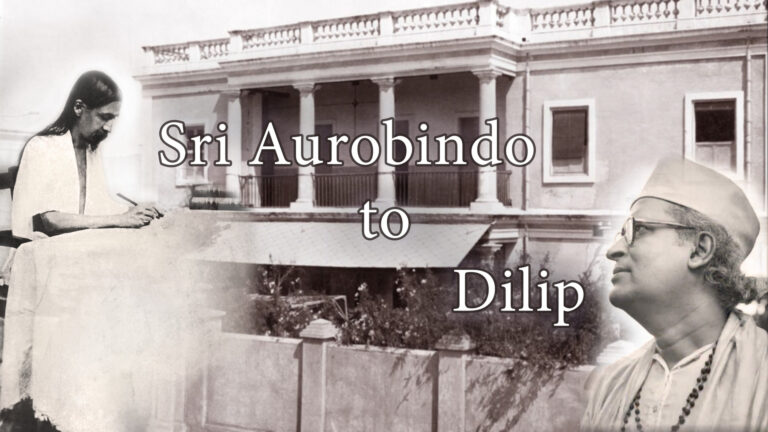We have already noted the coming of the Mother to Pondicherry, her meeting with Sri Aurobindo and her founding a society called “L’Idée Nouvelle” (The New Idea). On the 15th of August, 1914, (Sri Aurobindo’s birth day) Sri Aurobindo started a monthly journal called Arya. About the journal he wrote to a disciple later:
“…I knew precious little about philosophy before I did the Yoga and came to Pondicherry — I was a poet and a politician, not a philosopher. How I managed to do it and why? First, because X proposed to me to cooperate in a philosophical review — and as my theory was that a Yogi ought to be able to turn his hand to anything, I could not very well refuse; and then he had to go to the war and left me in the lurch with sixty-four pages a month of philosophy all to write by my lonely self. Secondly, because I had only to write down in the terms of the intellect all that I had observed and came to know in practising Yoga daily and the philosophy was there automatically. But that is not being a philosopher!”
A French version of the magazine, Revue de la Grande Synthése (A Review of the Great Synthesis) was also published at the same time.[1]
Arya was printed at the Modern Press, Pondicherry, and published from 7, Rue Dupleix, where the Mother was staying. It was called a Review of Pure Philosophy.
The object which it set before itself was twofold: —
“1. A systematic study of the highest problems of existence;
“2. The formation of a vast Synthesis of knowledge, harmonising the diverse religious traditions of humanity occidental as well as oriental. Its method will be that of a realism, at once rational and transcendental, — a realism consisting in the unification of intellectual and scientific discipline with those of intuitive experience.
“This Review will also serve as an organ for the various groups and societies founded on its inspiration.
“The Review will publish: —
“Synthetic studies in speculative Philosophy.
“Translations and commentaries of ancient texts.
“Studies in Comparative Religion.
“Practical methods of inner culture and self-development.”
Referring to the aim and object of the Arya, Sri Aurobindo declared again:
“Its object is to feel out for the thought of the future, to help in shaping its foundations and to link it to the best and most vital thought of the past.
“The earth is a world of Life and Matter, but man is not a vegetable nor an animal, he is a spiritual and thinking being who is set here to shape and use the animal mould for higher purposes, by higher motives, with a more divine instrumentation.
“The problem of thought is to find out the right idea and the right way of harmony; to restate the ancient and eternal spiritual truth of Self so that it shall re-embrace, permeate and dominate the mental and physical life; to develop the most profound and vital methods of psychological self-discipline and self-development so that the mental and psychical life of man may express the spiritual life through the utmost possible expansion of its own riches, power and complexity; and to seek for the means and motives by which his external life, his society and his institutions may remould themselves progressively in the truth of the spirit and develop towards the utmost possible harmony of individual freedom and social unity.
“This is our ideal and our search in the Arya. “Philosophy is the intellectual search for the fundamental truth of things, religion is the attempt to make the truth dynamic in the soul of man. They are essential to each other.
“Our first preoccupation in the Arya has therefore been with the deepest thought that we could command on the philosophical foundations of the problem; and we have been so profoundly convinced that without this basis nothing we could say would have any real, solid and permanent value that we have perhaps given too great a space to difficult and abstruse thought…”
The contents of the first issue of the Arya were as follows:
The Life Divine
The Wherefore of the Worlds
The Secret of the Veda
- a) The Problem and its Solution
- b) Selected Hymns
Annotated Texts — Isha Upanishad
The Synthesis of Yoga
The Eternal Wisdom
Varieties — The Soul of a Plant
The Question of the Month
The News of the Month
We find that Sri Aurobindo started in the Arya with his magnum opus, The Life Divine, and The Secret of the Veda, and The Synthesis of Yoga — all three embodying the philosophical, the mystical, and the psychological and spiritual expressions of his Yogic experiences. The Secret of the Veda gives an entirely new mystical interpretation of the symbolic verses of the Veda and throws a new light on the history of ancient Indian spiritual culture.
It should be recalled that Sri Aurobindo’s mind fell silent when he meditated with the Yogi Lele for three days in Baroda in December, 1907, and he ceased to think at all. All that he spoke and wrote since then came down to him from the higher planes of consciousness above the thought-mind.Under the caption, The Question of the Month, Sri Aurobindo wrote in the first issue of the Arya:
“What is the Synthesis needed at the present time?
“Undoubtedly, that of man himself. The harmony of his faculties is the condition of his peace, their mutual understanding and helpfulness the means of his perfection. At war, they distract the kingdom of his being; the victory of one at the expense of another maims his self-fulfilment.
“The peculiar character of our age is the divorce that has been pronounced between reason and faith, the logical mind and the intuitive heart. At first, the declaration of war between them was attended by painful struggles, a faith disturbed or a scepticism dissatisfied. But now their divorce has created exaggerated tendencies which impoverish human life by their mutual exclusiveness, on the one side a negative and destructive critical spirit, on the other an imaginative sentiment which opposes pure instinct and a faith founded on dreams to the sterile fanaticism of the intellect.
“Yet a real divorce is impossible. Science would not move a step without faith and intuition and to-day it is growing full of dreams. Religion could not stand for a moment if it did not support itself by the intellectual presentation, however inadequate, of profound truths. To-day we see it borrowing many of its weapons from the armoury of its opponent. But a right synthesis in virtue of a higher and reconciling truth can alone dissipate their mutual misunderstandings and restore to the race its integral self-development.
“The synthesis then of religious aspiration and scientific faculty, as a beginning; and in the resultant progress an integrality also of the inner existence. Love and knowledge, the delight of the Bhakta and the divine science of the knower of Brahman, have to effect their unity; and both have to recover the fullness of Life which they tend to banish from them in the austerity of their search or the rapture of their ecstasy.
“The heart and the mind are one universal Deity and neither a mind without a heart nor a heart without a mind is the human ideal. Nor is any perfection sound and real unless it is also fruitful. The integral divine harmony within, but as its result a changed earth and a nobler and happier humanity.”
In reply to a question on the significance of the word Arya, Sri Aurobindo wrote in the September, 1914 issue of the Arya:
“The question has been put from more than one point of view. To most European readers the name[2] figuring on our cover is likely to be a hieroglyph which attracts or repels according to the temperament. Indians know the word, but it has lost for them the significance which it bore to their forefathers. Western Philology has converted it into a racial term, an unknown ethnological quantity on which different speculations fix different values. Now, even among the philologists, some are beginning to recognise that the word in its original use expressed not a difference of race, but a difference of culture. For in the Veda the Aryan peoples are those who had accepted a particular type of self-culture, of inward and outward practice, of ideality, of aspiration. The Aryan gods were the supra-physical powers who assisted the mortal in his struggle towards the nature of the godhead. All the highest aspirations of the early human race, its noblest religious temper, its most idealistic velleities of thought are summed up in this single vocable.
“In later times, the word Arya expressed a particular ethical and social ideal, an ideal of well-governed life, candour, courtesy, nobility, straight dealing, courage, gentleness, purity, humanity, compassion, protection of the weak, liberality, observance of social duty, eagerness for knowledge, respect for the wise and learned, the social accomplishments. It was the combined ideal of the Brahmana and the Kshatria. Everything that departed from this ideal, everything that tended towards the ignoble, mean, obscure, rude, cruel or false, was termed un-Aryan. There is no word in human speech that has a nobler history.
“In the early days of comparative Philology, when the scholars sought in the history of words for the prehistoric history of peoples, it was supposed that the word Arya came from the root Ar, to plough, and that the Vedic Aryans were so called when they separated from their kin in the northwest who despised the pursuits of agriculture and remained shepherds and hunters. This ingenious speculation has little or nothing to support it. But in a sense we may accept the derivation. Whoever cultivates the field that the Supreme Spirit has made for him, his earth of plenty within and without, does not leave it barren or allow it to run to seed, but labours to exact from it its full yield, is by that effort an Aryan.
“If Arya were a purely racial term, a more probable derivation would be Ar, meaning strength or valour, from ar to fight, whence we have the name of the Greek wargod Ares areios, brave or warlike, perhaps even arete, virtue, signifying, like the Latin virtus, first, physical strength and courage and then moral force and elevation. This sense of the word also we may accept. ‘We fight to win sublime Wisdom, therefore men call us warriors’. For Wisdom implies the choice as well as the knowledge of that which is best, noblest, most luminous, most divine. Certainly, it means also the knowledge of all things and charity and reverence for all things, even the most apparently mean, ugly or dark, for the sake of the universal Deity who chooses to dwell equally in all. But, also, the law of right action is a choice, the preference of that which expresses the godhead to that which conceals it. And the choice entails a battle, a struggle. It is not easily made, it is not easily enforced.
“Whoever makes that choice, whoever seeks to climb from level to level up the hill of the divine, fearing nothing, deterred by no retardation or defeat, shrinking from no vastness because it is too vast for his intelligence, no height because it is too high for his spirit, no greatness because it is too great for his force and courage, he is the Aryan, the divine fighter and victor, the noble man, aristos, best, the śreṣṭha of the Gita.
“Intrinsically, in its most fundamental sense, Arya means an effort or an uprising and overcoming. The Aryan is he who strives and overcomes all outside him and within him that stands opposed to the human advance. Self-conquest is the first law of his nature. He overcomes earth and the body and does not consent like ordinary men to their dullness, inertia, dead routine and tamasic limitations. He overcomes life and its energies and refuses to be dominated by their hungers and cravings or enslaved by their rajasic passions. He overcomes the mind and its habits, he does not live in a shell of ignorance, inherited prejudices, customary ideas, pleasant opinions, but knows how to seek and choose, to be large and flexible in intelligence even as he is firm and strong in his will. For in everything he seeks truth, in everything right, in everything height and freedom.
“Self-perfection is the aim of his self-conquest. Therefore what he conquers he does not destroy, but ennobles and fulfils. He knows that the body, life and mind are given him in order to attain to something higher than they; therefore they must be transcended and overcome, their limitations denied, the absorption of their gratifications rejected. But he knows also that the Highest is something which is no nullity in the world, but increasingly expresses itself here, — a divine Will, Consciousness, Love, Beatitude which pours itself out, when found, through the terms of the lower life on the finder and on all in his environment that is capable of receiving it. Of that he is the servant, lover and seeker. When it is attained, he pours it forth in work, love, joy and knowledge upon mankind. For always the Aryan is a worker and warrior. He spares himself no labour of mind or body whether to seek the Highest or to serve it. He avoids no difficulty, he accepts no cessation from fatigue. Always he fights for the coming of that kingdom within himself and in the world.
“The Aryan perfected is the Arhat. There is a transcendent Consciousness which surpasses the universe and of which all these worlds are only a side-issue and a by-play. To that consciousness he aspires and attains. There is a Consciousness which, being transcendent, is yet the universe and all that the universe contains. Into that consciousness he enlarges his limited ego; he becomes one with all beings and all inanimate objects in a single self-awareness, love, delight, all-embracing energy. There is a consciousness which, being both transcendental and universal, yet accepts the apparent limitations of individuality for work, for various stand-points of knowledge, for the play of the Lord with His creations; for the ego is there that it may finally convert itself into a free centre of the divine work and the divine play. That consciousness too he has sufficient love, joy and knowledge to accept; he is puissant enough to effect that conversion. To embrace individuality after transcending it is the last and divine sacrifice. The perfect Arhat is he who is able to live simultaneously in all these three apparent states of existence, elevate the lower into the higher, receive the higher into the lower, so that he may represent perfectly in the symbols of the world that with which he is identified in all parts of his being, — the triple and triune Brahman.”
Under the Heading, The News of the Month, it was announced: The War.
“The Arya, a Review of pure Philosophy, has no direct concern with political passions and interests and their results. But neither can it ignore the enormous convulsion which is at present in progress, nor at such a time can it affect to deal only with the pettier happenings of the intellectual world as if men were not dying in thousands daily, the existence of great empires threatened and the fate of the world hanging in the balance. The War has its aspects of supreme importance to a synthetic Philosophy, with which we would have the right to deal. But now is not the hour, now in this moment of supreme tension and widespread agony. Therefore, for the time, we suppress this heading in our Review and shall replace it by brief notes on subjects of philosophical interest, whether general or of the day. Meanwhile, with the rest of the world, we await in silence the predestined result.”
On the completion of first year of the Arya, Sri Aurobindo announced in the July number of 1915:
“The Arya, born by a coincidence which might well have been entirely disastrous to its existence in the very month when there broke out the greatest catastrophe that has overtaken the modern world, has yet, though carried on under serious difficulties, completed its first year….

“We have been obliged in our first year for reasons we shall indicate in the preface to our August number to devote the Review almost entirely to high philosophy and severe and difficult thinking. But the object we had in view is now fulfilled and we recognise that we have no right to continue to subject our readers to the severe strain of almost 64 pages of such strenuous intellectual labour. We shall therefore in the next year devote a greater part of space to articles on less profound subjects written in a more popular style. Needless to say, our matter will fall within the definition of a philosophical Review and centre around the fundamental thought which the Arya represents.
“We shall continue The Life Divine, The Synthesis of Yoga and The Secret of the Veda; but we intend to replace the Selected Hymns by translation of the Hymns of the Atris (the fifth Mandala of the Rig Veda) so conceived as to make the sense of the Vedic chants at once and easily intelligible without the aid of a commentary to the general reader….
“Without the divine Will which knows best what to use and what to throw aside, no human work can come to the completion hoped for by our limited vision. To that Will we entrust the continuance and the result of our labours and we conclude the first year of the Arya with the aspiration that the second may see the speedy and fortunate issue of the great world-convulsion which still pursues us and that by the Power which brings always the greatest possible good out of apparent evil there may emerge from the disastrous but long-foreseen collapse of the old order a new and better marked by the triumph of higher principles of love, wisdom and unity and a sensible advance of the race towards our ultimate goal, — the conscious oneness of the Soul in humanity and the divinity of man.”
[1] It was discontinued after some time.
[2] Referring to the word “Arya” written in Devanagari characters.



About Savitri | B1C1-10 The Response of Earth (p.5)